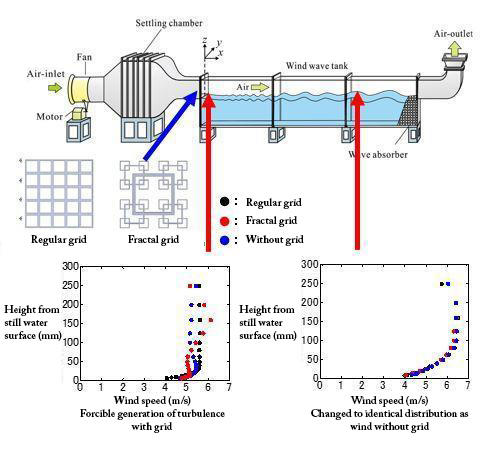Discovering the mechanism for the development of wind waves affected by air-side freestream turbulence
2020.05.28
A research group including Naohisa Takagaki (assistant professor, Graduate School of Engineering, University of Hyogo), Hiroshige Kumamaru (professor emeritus at the University of Hyogo), and Naoya Suzuki (professor, Department of Mechanical Engineering, Faculty of Science and Engineering, Kindai University) conducted experiments to understand the mechanism involved in the generation of wind waves. Understanding wind waves is important for accurate modeling of turbulent transfer (momentum, heat, material) in the atmosphere and oceans, one of the fundamental factors affecting fluctuations in and changes to climate systems. The research used a wind-wave tank at Kindai University as an ocean-simulation device to compare the generation of wind waves under different grid fluctuation turbulence fields. It confirmed that regardless of the speed fluctuation intensity of the air-side freestream turbulence, wind waves were only generated at average wind speed.
The results of this research were published in the May 25, 2020 issue of the journal Experiments in Fluids.
Abstract
Since turbulence in the boundary layer just above the surface layer of the open ocean manifests itself on the ocean surface and is accompanied by the development of wind waves, we know that such turbulence is related to the development of wind waves. Also, air-side freestream turbulence can occur due to the presence of mountains, westerly winds, trade winds, etc. Although having no connection to boundary layer turbulence, freestream turbulence contains a great amount of energy so that it might be expected to impact the development of wind waves. However, as of yet research has not shown clear effects of air-side freestream turbulence on the development of wind waves.
The experiments carried out for this research used a wind-wave tank (an ocean-simulation device) at Kindai University equipped with two kinds of turbulence-generating grids (regular, fractal) to forcibly generate different turbulence fields on the air side. Reviewing the effects of air-side freestream turbulence on the development of wind waves confirmed that wind waves in any area of turbulence are consistent with those of pure wind-driven waves. This suggests that the effects of air-side freestream turbulence on wave development are negligible.
Introduction
In recent years, global warming has been causing serious problems, including a rise in sea level, desertification, and abnormal weather. That is especially true of rapidly increasing damage from typhoons, hurricanes, "bomb cyclone" low-pressure systems, and other abnormal weather conditions.
In order to take effective measures to deal with such destruction, accurate forecasting of climate change attributable to global warming is critical. For that reason, it is important to be able to accurately determine turbulent transfer (momentum, heat, material) in the atmosphere and within the ocean, which is one of the basic elements determining fluctuation and change in weather systems.
In general, atmospheric and oceanic momentum flux is empirically determined. However, the coefficient used with this method only provides the exponential function for wind velocity for the sake of convenience and does not take into consideration the impact of boundary processes on the sea surface, including various phenomenon of varying scale, such as wind waves, breaking waves, and air bubble formation.
For that reason, the coefficient values for wind velocity fluctuate considerably and up until now no model yielding accurate values had been established.
With open measurements it is very difficult to achieve accurate measurements of the ocean surface in terms of various sampled phenomena, such as current velocity, temperature, or concentration, with measurement devices limited to established locations since the sea surface is an unsteady, complex environment in which wind and waves exhibit constant change.
Therefore, researchers used wind-wave (turbulence-generating) water tanks, which are ocean condition simulation devices that make possible accurate measurements of turbulence for stationary wind wave turbulence fields with a broad range of wind speeds from low to extremely high. Such experiments are important for understanding in detail the mechanisms behind atmospheric and oceanic momentum transfer through accurate measurements of current speed, temperature, concentration, etc.
Research Article
Journal Name: Experiments in Fluids
Article Name: "Effects of air-side freestream turbulence on the development of air-liquid surface waves"
Authors: Naohisa Takagaki (University of Hyogo), Naoya Suzuki (Kindai University), Shunsaku Takahata (Graduate School of Engineering, University of Hyogo), Hiroshige Kumamaru (professor emeritus, University of Hyogo)
Publication Date: May 25, 2020
DOI: https://doi.org/10.1007/s00348-020-02977-9
Research Grants
1. Research Expense Name: Grant-in-Aid for Scientific Research
Research Classification: Basic research (B)
Research Title: Effects of changes in wind waves and wind speed on the sea surface friction coefficient
Research Representative: Naoya Suzuki (Kindai University)
2. Research Expense Name: Grant-in-Aid for Scientific Research
Research Classification: Basic research (C)
Research Title: Explaining the mechanism behind momentum transfer through ultra-high-density bubble (cushion) layer formed by high-speed air currents on the water surface
Research Representative: Naohisa Takagaki (University of Hyogo)
3. Research Expense Name: Grant-in-Aid for Scientific Research
Research Classification: Promoting International Joint Research (B)
Research Title: Explaining and modeling the heat and momentum transfer mechanism on the sea surface under intense typhoon conditions
Research Representative: Naohisa Takagaki (University of Hyogo)

